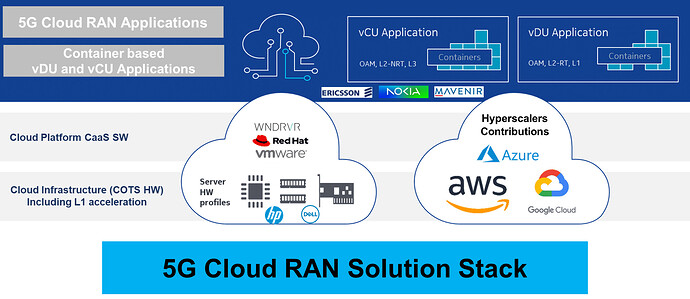-
My friend: Hi Ibrahim, I have a question for you.
- Me: Go ahead, please.
-
My friend: I was wondering what are the challenges that are facing the Cloud RAN deployments?
- Me: Actually, Cloud RAN deployments are facing many challenges. One of these challenges is to guarantee continuous interoperability between the different vendors providing each part of the solution. As the Cloud RAN solution consists of multiple layers such as the Cloud Infrastructure layer (COTS HW), cloud platform layer, application layer where the CU/DU SW functions exist, and the orchestration layer. So, each of these layers should work together, not only at deployment, but later when any vendor updates or upgrades any HW or SW in any layer at the whole solution. Also, performance is a critical point as Cloud RAN is expected to provide similar if not better performance than Purpose-built RAN, that’s why for example we are using L1 acceleration with COTS HW.
-
My friend: So, what else can be a challenge for Cloud RAN deployment?
- Me: If you are going to implement centralized RAN, that means searching for new locations or data centers to host the centralized CU/DU functions based on your RAN design which means extra cost. Also, the cloud infrastructure needs to be able to handle the stringent requirements of fronthaul transport such as high capacity and low latency. While for distributed RAN, in which baseband processing functions (DU functions) are deployed at antenna sites. This could mean as little as one compute node deployed at a physically isolated site, and this can put extra stress on the design of cloud platforms as we may have 100s of thousands of isolated sites that each contain one compute node only. While, cloud platforms need to work on minimal processor and memory footprint, whilst meeting the requirements of a containerized DU workload.
-
My friend: But what about security, is it a concern or not?
- Me: Security is a big concern specially with disaggregation of HW& SW and with deployments in public and hybrid cloud. As the cloud expands the 5G attack surface and introduces new threats to critical infrastructure, so a strong Cloud RAN security posture requires a defense-in-depth approach, with the goal of achieving secure critical infrastructure built upon zero-trust architecture (ZTA) to protect from internal and external threats. Also, Cloud RAN should offer service availability and reliability, which are the most important characteristics of mobile networks, similar to the purpose-built RAN solutions.
-
My friend: Thank you very much, you made it very clear.
- Me: You are most welcome.
LinkedIn: ![]()
